语言与文化(Language and Culture)
- 格式:doc
- 大小:29.50 KB
- 文档页数:5
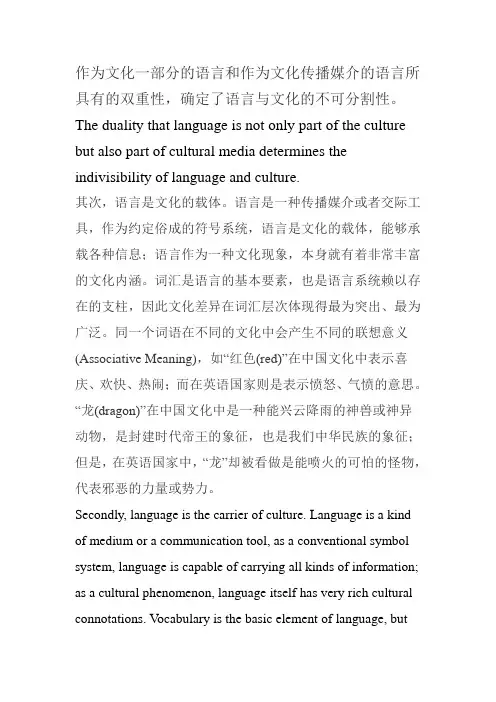
作为文化一部分的语言和作为文化传播媒介的语言所具有的双重性,确定了语言与文化的不可分割性。
The duality that language is not only part of the culture but also part of cultural media determines the indivisibility of language and culture.其次,语言是文化的载体。
语言是一种传播媒介或者交际工具,作为约定俗成的符号系统,语言是文化的载体,能够承载各种信息;语言作为一种文化现象,本身就有着非常丰富的文化内涵。
词汇是语言的基本要素,也是语言系统赖以存在的支柱,因此文化差异在词汇层次体现得最为突出、最为广泛。
同一个词语在不同的文化中会产生不同的联想意义(Associative Meaning),如“红色(red)”在中国文化中表示喜庆、欢快、热闹;而在英语国家则是表示愤怒、气愤的意思。
“龙(dragon)”在中国文化中是一种能兴云降雨的神兽或神异动物,是封建时代帝王的象征,也是我们中华民族的象征;但是,在英语国家中,“龙”却被看做是能喷火的可怕的怪物,代表邪恶的力量或势力。
Secondly, language is the carrier of culture. Language is a kind of medium or a communication tool, as a conventional symbol system, language is capable of carrying all kinds of information; as a cultural phenomenon, language itself has very rich cultural connotations. V ocabulary is the basic element of language, butalso the backbone upon which the language system can exist, therefore the cultural differences in vocabulary level is the most prominent and the most widely. The same words in different cultures can produce different associative meanings, such as “red” in Chinese culture represents festive,cheerful,lively and good luck; while in the English-speaking countries it means angry and violence. “Dragon” in Chinese culture is a miraculous animal, it is a symbol of the emperor in the feudal era, but also a symbol of our nation; However, in the English-speaking countries, “dragon” is regarded as the horrible monster which is capable of spraying fire a nd represents evil power or forces.文化差异在习语(Idiom)中体现得更为突出。

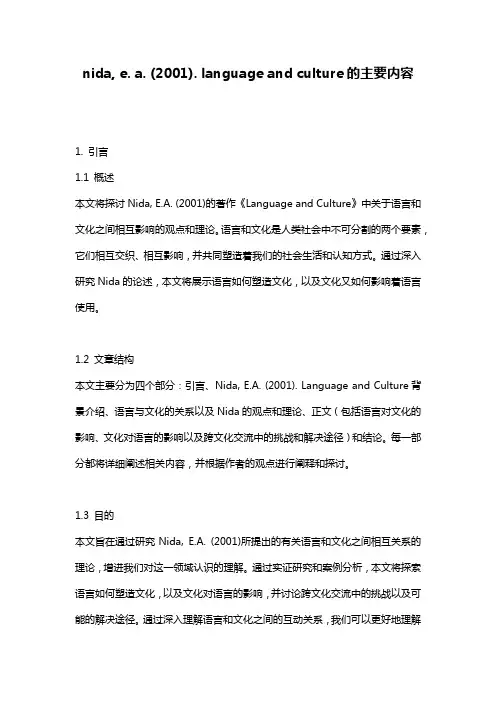
nida, e. a. (2001). language and culture的主要内容1. 引言1.1 概述本文将探讨Nida, E.A. (2001)的著作《Language and Culture》中关于语言和文化之间相互影响的观点和理论。
语言和文化是人类社会中不可分割的两个要素,它们相互交织、相互影响,并共同塑造着我们的社会生活和认知方式。
通过深入研究Nida的论述,本文将展示语言如何塑造文化,以及文化又如何影响着语言使用。
1.2 文章结构本文主要分为四个部分:引言、Nida, E.A. (2001). Language and Culture背景介绍、语言与文化的关系以及Nida的观点和理论、正文(包括语言对文化的影响、文化对语言的影响以及跨文化交流中的挑战和解决途径)和结论。
每一部分都将详细阐述相关内容,并根据作者的观点进行阐释和探讨。
1.3 目的本文旨在通过研究Nida, E.A. (2001)所提出的有关语言和文化之间相互关系的理论,增进我们对这一领域认识的理解。
通过实证研究和案例分析,本文将探索语言如何塑造文化,以及文化对语言的影响,并讨论跨文化交流中的挑战以及可能的解决途径。
通过深入理解语言和文化之间的互动关系,我们可以更好地理解多样性、发展跨文化教育方法并促进更有效的跨文化交流。
综上所述,本篇文章旨在探讨语言与文化之间的紧密联系并阐述Nida, E.A. (2001)在此领域的观点和理论。
以下部分将详细介绍Nida, E.A. (2001). Language and Culture的背景、语言与文化之间的关系以及相关问题。
2. Nida, E.A. (2001). Language and Culture:2.1 背景介绍:Nida, E.A.是一位著名的语言学家和翻译家,他对多种语言及其文化之间的关系进行了深入研究。
在他的著作《Language and Culture》中,他探讨了语言与文化之间的紧密联系,并提出了一些重要观点和理论。
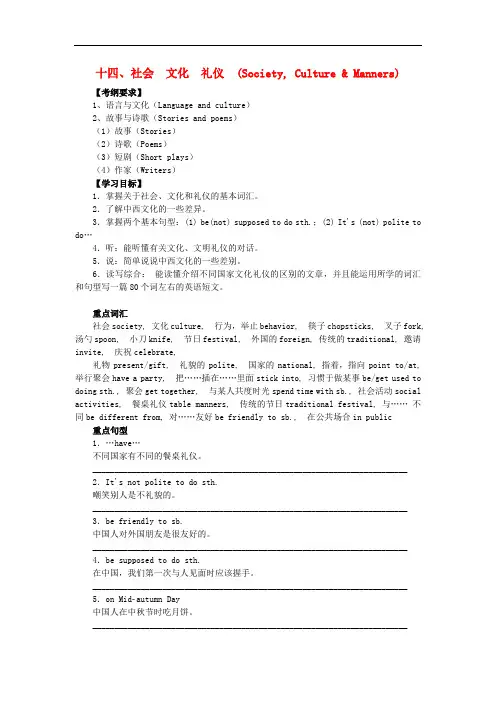
十四、社会文化礼仪 (Society, Culture & Manners)【考纲要求】1、语言与文化(Language and culture)2、故事与诗歌(Stories and poems)(1)故事(Stories)(2)诗歌(Poems)(3)短剧(Short plays)(4)作家(Writers)【学习目标】1.掌握关于社会、文化和礼仪的基本词汇。
2.了解中西文化的一些差异。
3.掌握两个基本句型:(1) be(not) supposed to do sth.;(2) It's (not) polite to do…4.听:能听懂有关文化、文明礼仪的对话。
5.说:简单说说中西文化的一些差别。
6.读写综合:能读懂介绍不同国家文化礼仪的区别的文章,并且能运用所学的词汇和句型写一篇80个词左右的英语短文。
重点词汇社会society, 文化culture, 行为,举止behavior, 筷子chopsticks, 叉子fork, 汤勺spoon, 小刀knife, 节日festival, 外国的foreign, 传统的traditional, 邀请invite, 庆祝celebrate,礼物present/gift, 礼貌的polite, 国家的national, 指着,指向point to/at, 举行聚会have a party, 把……插在……里面stick into, 习惯于做某事be/get used to doing sth., 聚会get together, 与某人共度时光spend time with sb., 社会活动social activities, 餐桌礼仪table manners, 传统的节日traditional festival, 与…… 不同be different from, 对……友好be friendly to sb., 在公共场合in public 重点句型1.…have…不同国家有不同的餐桌礼仪。
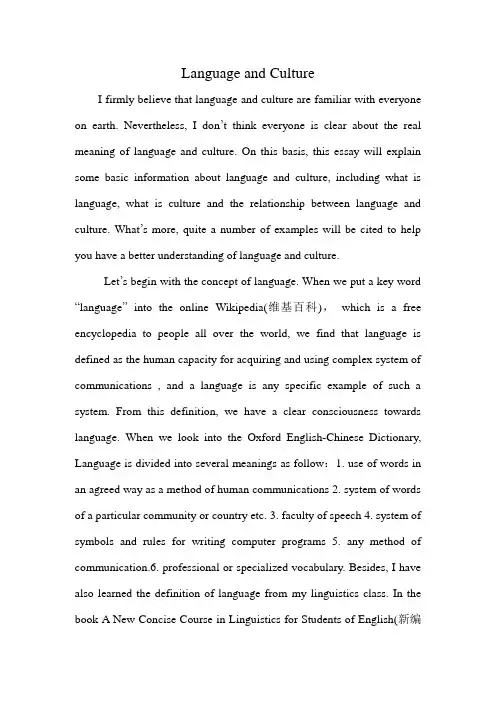
Language and CultureI firmly believe that language and culture are familiar with everyone on earth. Nevertheless, I don’t think everyone is clear about the real meaning of language and culture. On this basis, this essay will explain some basic information about language and culture, including what is language, what is culture and the relationship between language and culture. What’s more, quite a number of examples will be cited to help you have a better understanding of language and culture.Let’s begin with the concept of language. When we put a key word “language”into the online Wikipedia(维基百科),which is a free encyclopedia to people all over the world, we find that language is defined as the human capacity for acquiring and using complex system of communications , and a language is any specific example of such a system. From this definition, we have a clear consciousness towards language. When we look into the Oxford English-Chinese Dictionary, Language is divided into several meanings as follow:1. use of words in an agreed way as a method of human communications 2. system of words of a particular community or country etc. 3. faculty of speech 4. system of symbols and rules for writing computer programs 5. any method of communication.6. professional or specialized vocabulary. Besides, I have also learned the definition of language from my linguistics class. In the book A New Concise Course in Linguistics for Students of English(新编简明英语语言学教程). Langue is thought to be a system of arbitrary vocal symbol used for human communication. Short as it is, this definition has captured the main features of language. First of all, language is a system, that is, elements of language are combined according to rules. Second, language is arbitrary in the sense that theme is no intrinsic connection between a linguistic symbol and what the symbol stands for. This conventional nature of language is well illustrated by a famous quotation: A rose by any other name would smell as sweet. This quotation means rose is still rose even it is called by another name.For my part, the definition of language is varied. Generally speaking, it is a series code that facilitates human communication. And beyond a specific context, language has no intrinsic meaning.After finishing talking about what is language, let’s know more about culture. Similarly, in the Wikipedia, culture is defined as fallowing meanings, Firstly, culture is deemed as a modern concept based on a term first used in classical antiquity by the roman orator Cicero: Cultura animi ( cultiration of the soul). Secondly, the term “culture”in American anthropology had two meanings: the evolved human capacity to classify and represent experiences with symbol, and to act imaginatively and creatively. Thirdly, Hoebel describes culture as an integrated system of learned behavior patterns and which are not a result of biological inheritance. Besides, we learn the meaning of culture from theIntercultural Communication course. Culture is defined as the group of people who share the same ancestry. There are also many renowned socialists give culture several definitions. For example, E.sapir once said that culture may be defined as what a societu does and thinks.Shortly, culture is involved in so many aspects that it is hard to give it an accurate definition. Put in another way, for different people, culture has very different meaning, according to their own value, education background, social status and so forth. So there is nothing to criticize when other’s understanding of culture is different from yours.Having known so much basic information about language and culture, we will have look at the relationship between language and culture. In the book Intercultural communication in English(新编跨文化交际英语),there is a description of the relationship between language and culture. It goes like this: culture and language are intertwined and shape each other. Language is not a matter of neutral codes and grammatical rules. Each time we select words form sentences, and send a message, either oral or written. We also make cultural choices. We all agree that language helps in communication with people from different backgrounds. However, we may be less aware that cultural literary is necessary to understand the language being used. Personally speaking, language and culture is not two totally different subjects with no relevance. On the contrary, they are tightly related. That is to say, onlywhen language is put into a specific environment of cultural context does it have some real meaning.To have a better understanding of language and culture, several typical examples of the language and cultural difference between China and the western countries will be cited. We all know that the Chinese culture is both profound and extensive which leads to numerous idioms, allusions, proverbs and sayings, which is hard for foreigners to understand. Take some of them for instances. Firstly, take “过着牛郎织女的生活” for example, it can be literally translated as the Herd-boy and the spinning maid(mythical lovers separated by the Milky Way). But a foreigner may feel puzzled when look at this allusion, for they do not have the cultural background of the allusion. Actually, it is a folk tale of ancient China which means husband and wife living apart. If you want a foreigner fully understand this allusion, you’d better to tell him the whole tale, which also help him to know more about Chinese culture.There are also other four-character allusions in Chinese. Such as 三顾茅庐—make three calls at the thatched cottage(as Liu Bei did when he sought the aid of Zhuge Liang, a master straight then living in seclusion)—repeatedly request someone to take up a responsible post.完璧归赵——return the jade intact to the state of Zhao—return something to its owner in perfect condition.拔苗助长—stand by a stump waiting for hares to come and dash themselves against it—trust to chance and waiting forgains without pains.对牛弹琴—play music to an ox—cast pearls before swine.Most of the allusions come into being according to china’s long history. That’s why many foreigners find it hard to know comprehensively about Chinese language and culture. Nevertheless, there are some equivalents between these two different cultures. For example, in Chinese , there is an allusion called “画蛇添足” , in English, there is a similar proverb called gilding the lily. What’s more, it takes two to make a quarrel can be found in Chinese 一个巴掌拍不响. Hopefully, these make it easier to understand each other’s culture.In short, language in different cultures is hard to understand to most foreigners. The only thing to do is try one’s best to know more about each other’s culture, including all walks of life.。
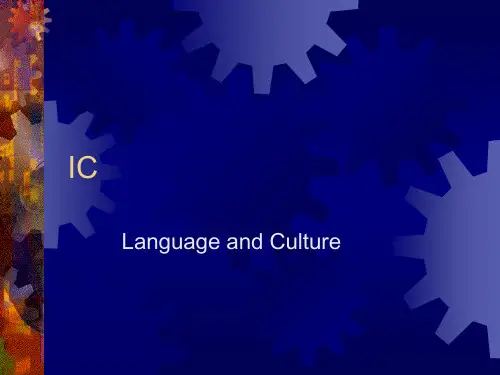
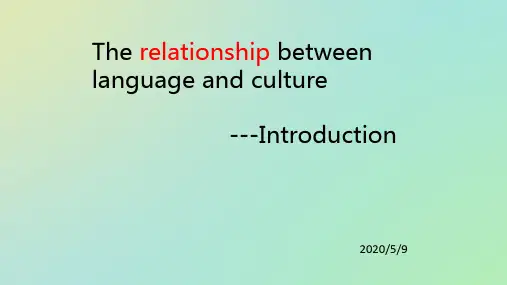
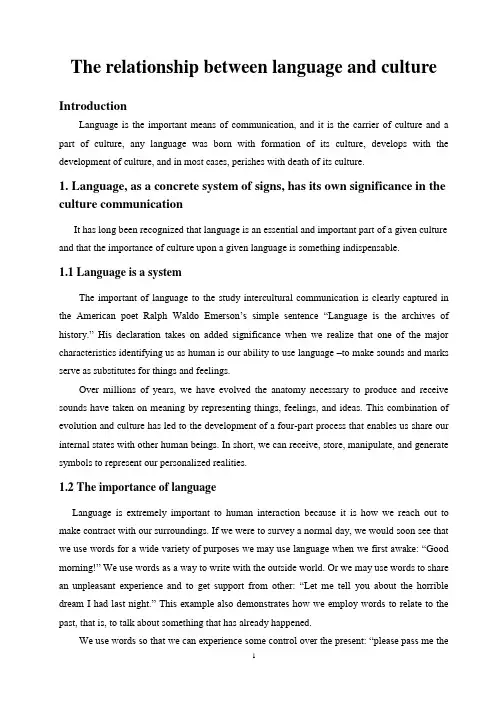
The relationship between language and cultureIntroductionLanguage is the important means of communication, and it is the carrier of culture and a part of culture, any language was born with formation of its culture, develops with the development of culture, and in most cases, perishes with death of its culture.1. Language, as a concrete system of signs, has its own significance in the culture communicationIt has long been recognized that language is an essential and important part of a given culture and that the importance of culture upon a given language is something indispensable.1.1 Language is a systemThe important of language to the study intercultural communication is clearly captured in the American poet Ralph Waldo Emerson’s simple sentence “Language is the archives of history.” His declaration takes on added significance when we realize that one of the major characteristics identifying us as human is our ability to use language –to make sounds and marks serve as substitutes for things and feelings.Over millions of years, we have evolved the anatomy necessary to produce and receive sounds have taken on meaning by representing things, feelings, and ideas. This combination of evolution and culture has led to the development of a four-part process that enables us share our internal states with other human beings. In short, we can receive, store, manipulate, and generate symbols to represent our personalized realities.1.2 The importance of languageLanguage is extremely important to human interaction because it is how we reach out to make contract with our surroundings. If we were to survey a normal day, we would soon see that we use words for a wide variety of purposes we may use language when we first awake: “Good morning!” We use words as a wa y to write with the outside world. Or we may use words to share an unpleasant experience and to get support from other: “Let me tell you about the horrible dream I had last night.” This example also demonstrates how we employ words to relate to the past, that is, to talk about something that has already happened.We use words so that we can experience some control over the present: “please pass me thesalt and pepper.” We each seek to affect our environment, to influence many lf the daily situations in which we find ourselves. Words, and how we manipulate them, permit us to make those alterations through symbolic transactions with others.We also use words to form images of the future: “I have meet with Jane at work today, but I dread seeing her, because I k now she’s going to be upset about the changes I’m making in her work schedule.” Our wording ability allows us to predict and describe the future .We use words to persuade to exchange ideas, to exchange ideas, to express views, to seek information, and to express feelings. When we study another language, we soon discover that the symbols, the sounds for those symbols, and the rules for using those symbols and sounds are different.2. Language, as a culture institution, is born with culture. It develops and interacts with the cultureTo preserve the language of a nation is to preserve its special culture and history. When people can not understand the old language, they will be less tightly connected to or even gradually lose their cultures and histories. Their enemies know much more clearly than themselves as to this point.We still remember that in the famous article The Last Lesson, the first thing Prussians did when they intruded France, was to replace French with Prussian in the school education. Japanese also took the same strategy in order to cut off the connection between people and their histories and cultures. This evil refused to only stay in people's memory and is still threatening certain cultures and nations. Thus both Jews and Tibetans are still fighting to preserve their languages for the sake of their cultures and histories at the edge of being extinguished.2.1 Explain the meaning of the cultureWhen delivering daily speech, the word "culture" refers to pursuits such as literature and music. More broadly, we can define "culture" as all the modes of thought, behavior, and production that are handed down from one generation to the next by means of communicative interaction── speech, gesture, epic, construction, and all other communication among hu mans── rather than by genetic transmission or heredity. "Culture" is an essential concept for it is what makes humans unique in the animal kingdom. All familiar forms of social organizations, ranging from the simplest family to the most sophisticated corporation depend upon "culture" for their existence. Nevertheless, "society" and "culture" might be confusing forone to distinguish. "Society" is population that is organized to carry out the major function of life.A society's "culture" consists of all the ways in which its members think about it among themselvesCulture, in a broad sense, means the total way of life of a people, including the patterns of belief, customs, objects, institutions, techniques, and language that characterizes the life of the human community. As culture is so inclusive, it permeates virtually every aspect of human life and influences predominantly people’s behavior, including linguistic behavior. In a narrow sense, culture may refer to local or specific practice, belief or customs, which can be mostly found in folk culture, enterprise culture or food culture etc.Generally speaking, there are two types of culture: material and spiritual. While material culture, as the term itself suggests, is concrete, substantial and observable, most of spiritual culture, the products of mind, is abstract, ambiguous, and hidden. In contrast with nature in the sense of what is born and grows, culture refers to what has been grown and brought up with, in other words, what can be nurtured. Culture, especially material culture, is reproduced and preserved through the maintaining of beliefs, traditions, education and other institution mechanisms, mean while, it changes slowly with the development of the society.2.2 The relationship between language and cultureWe begin our preview of language by noting that it is impossible to separate our use if language from our culture. In its most basic sense, language is a set of symbols and the rules for combining those symbols that are used and understood by a large community of people. When we study another language, we soon discover that not only are the symbol and sounds for those symbols different, but so are the rules (phonology, grammar, syntax, and intonation) for using those symbols and sounds.Word different are obvious in various language. In English, we live in a house. In Spanish, we live on a case. In Thai we live in a ban. Phonology also varies culturally. In English, we have 21 consonant sounds and 5 vowels that combine to from 38 various sounds. “Vie tnamese has 34 segmental phonemes consisting of vowels, semivowels and consonants.” The Filipino language has 16 consonants and 10 vowels forming 26 phonemes. Portuguese has 21 consonants and 13 vowels that form 34 basic phonemes. Grammatical structures are unique to each language as well. In English verb tenses express contrast between past, present, and future acts, but in Vietnamese, the same verb reflects all three and the time of action is inferred from the context. Syntax, or theword order and structure of sentences, also varies depending on the language. The normal woes order for simple sentences in Filipino is the reverse of the word order in English. That is, the predicate is followed by the subject. For example, the English sentence “The teacher died” would be “Namatay ang guro” or “died the teacher” in Filipino. In English, the subject is followed by a verb and then an object, but in Korean, the subject is followed by the object and then the verb. So in English we might say, “The cat ate the mouse,” but in Korean, “Cat mouse ate” would be correct.These examples indicate that if we want to communicate in another language, it is important for us to know not only the symbols of that language, but also the rules for using those symbols. As you know language is much more than a symbol and rule system that allows us to communicate with another person-language also shapes the process by which people became introduced to the order of the physical and social environment. As Nanda indicates, “language, therefore, would seem to have major impact on the way an individual perceives and conceptualizes the world.”2.2.1Language not only express a person’s meaning but also express a nation’s cultureWe can have different meanings for the same word. For instance, to one person, the woes grass might mean something in front of then house that is green, has to be watered, and must be mowed once a week: to another person, grass may mean something that is rolled in paper and smoked. All people, drawing on their backgrounds, decide what a word means. People have similar meanings only to the experience includes baseball, to us a rope is a line driver. If our background lies in the world of jazz music, the word ax does not indicate something used to chop wood but any horn or woodwind instrument. And it is likely that we and a physician respond differently to the woes cancer.If we include culture as a variable on the process of abstracting meaning, the problems became all the more acute, for culture teaches us both the symbol and what the symbol represents. When you are communicating with someone from your own culture, the process of using words to represent your experience is much easier because within a culture people share many similar experiences. But when communication is between people from distinct cultures, different experiences are involved and the process is more troublesome. Objects, events, experiences, and feelings have the labels or names they do because a community id people arbitrarily decided to so name them. If we extent this notion to the intercultural setting, we can see that diverse cultures can have both different symbols and different responses.There are even differences between British and American usage in word meanings. Although some words are spelled and pronounced the same, they have different meanings. For instance, the words boot, bonnet, lift, and biscuit in British English translate into American English as car trunk, car hood, elevator, and cookie. In the area of business, there are also some interesting differences. For example, the British term annual gunnel meeting translates in American English as annual meeting of shareholders; scheme translates as pension plan. From these examples, we see that culture exerts an enormous influence on language because culture teaches not rules for using those symbols and rules for using those symbols, but more important, the meaning associate with the symbols. Further, culture influences the way people use language.2.2.2 Language and its culture influence are exemplified in the theoretical formulations of the Sapir-Whorf hypothesisLanguage and its culture influence are exemplified in the theoretical formulations of the Sapir-Whorf hypothesis, which in essence states that language is a guide to “social reality.” T his hypothesis implies that language is not simply a means of reporting experience but, more important, it is a way of defining experience. Sapir wrote:Human beings do not live in the objective world alone, nor alone in the world of social activity as ordinarily understood, but are very much at the mercy of the particular language which has become the medium of expression for their society …The real world is to a large extent unconsciously built up on the language habits of the group. No two languages are ever sufficiently similar to be considered as representing the same social reality. The worlds in which different societies live are distinct worlds, not merely the same world with different labels attached. Nanda provides an excellent example if the Sapir-Whorf concept in practice: If my language has only one term-brother-in-law- that is applied to my sister’s husband, my husband’s brothers, and my husband’s sisters’ husbands, I am led by my language to perceive all of these relatives in a similar way. Vocabulary, through what it groups together under one label and what it differentiates with different labels, is one way in which language shapes our perception of the world.3. Linguistic evidence of cultural differenceAny linguistic may be simultaneously of a denotative, connotative, or iconic kind of meanings. To begin with, any sign has a meaning that can be found in a dictionary, this is the denotative meaning. For example, “rose” is a flower that has a pleasant smell and is usually red,pink, white, or yellow etc. On most occasions “rose” means more than a flower, it also triggers many associations mostly good ones such as love, fragrance, passion and beauty etc. These are its connotations or connotative meanings. Moreover, the word “rose” also invok es image to people. The famous line “my love is a red rose” stirs up vividly the imagination if a beautiful young lady. This is the iconic meanings.All these types of meanings are bound with culture encodings from their associations. Each language has its own metaphors that provide semantic cohesion within its boundaries. Motivated by the need and desire to influence others, people choose to use words which emphasize denotative meaning, connotative meaning or iconic meanings or all of them, during the same process its cultural meanings are created.The following are some illustrations of the cultural differences in language use which we may often come across in our daily life.3.1 A Comparison of Chinese and British Hospitality in Treating GuestsIn China, people’s hospitality is shown by the number of the dishes offered as well as by the eagerness to impress the guest with the most expensive and nutritious food.While in Britain, people value equality. Their hospitality is shown by treating the guest as an equal with the host. Believing in simplicity regarding food, they may offer their guest the same type of meal they usually eat. Part of the reason is their egalitarianism and other reason is that the host wants to introduce the foreign guest to British food and eating customs, and make the guest feed comfortable.The foreign guest might think of the saying. “When in Rome, do as the Romans do.”3.2Different Topics between China and West Common topics in China3.2.1Common topic in ChinaSince there is not much privacy that is found in China. People feel free to ask almost any question without being offensive. The most common topics are age, income, property, family life, especially children, politics and religion. Also, when a purchase, is made, Chinese people will often ask or voluntarily tell the item’s price in order to share the happiness of shopping. But most Westerns feel it very inappropriate to talk about the price of products they have purchased. That information is considered private, so question about price should not be asked.Elderly people are highly respected in China, of “old” means wisdom and experience, theolder the better. Males especially will often ask about each other’s age to show respect for the elder one. And the elder one feels very happy to be addressed as “lao” plus surname.Today, more and more Chinese women, who have been influence by the Western cultures, do not want to give their ages.However, it is very rude for person to address the senior or the elder only by their family names. Some topics concerning the death will always be avoided.3.2.2 Common topics in the westPeople in the West like to talk about the weather, sports, news, traveling, interests and hobbies. Do not ask personal questions about age, weight, illness, income, property, religion and politics. In general conversations asking about these political issues. Beware that politics is an “emotionally changed” topic because the people in the conversation may have differing viewpoints within the group.General question about family can be asked to start a conversation. You may ask if a person is single or married. Depending on how the conversation is going, you can either ask directly by saying, “Are you single?” or “Are you married?” or indirectly by saying, “Do yo u have a family?”3.3 Friendship3.3.1 Friendship in ChinaIn China most people expert their friends to do for then when they are in need. There is an obligation to a friendship. People feel obligated and a duty to do for their friends. We have a lot for Chinese sayings concerning friendship:“为朋友两肋插刀”(people can take any risks, even risk of their lives, especially among male friends, to do everything for their friends disregarding whether it’s right or wrong);“有难同当,有福同享” (people can not only share bitterness ,hardships but also happiness with their friends). Other proverb and sayings such as “一个篱笆三个桩,一个好汉三个帮”(As one fence needs three stakes, a good guy needs three fellows.)“在家靠父母,出门靠朋友”(It is your parents that you can rely on at home, but it is your friends that you can count in when out in the society ), show that friendship really counts or is very important to a person in the society.Having friends reflects having a good personality you have and more sociable you are. Your life will be better if you have more friends, and will be worse without friends. One needs a friend to help him or her out when difficulties occur, and one needs a friend to offer financial supportwhen there is a lack of money. So in other words, one cannot be without friends in his or her life. Actually, there is a lot to say about Chinese friendships, and I am sure you have more explanations you can add to this list because of a better understanding of your own personal friendships.3.3.2Friendship in the United StatesIn general, American has causal, friendly relationships with many people, but deeper, closer friendships with only a few. Friendship requires time and commitment (The state of being bound emotionally or intellectually to a course of action or to another person or persons) and depending on the American is commitment to family, which is a priority, and time require for work or school, various types of friendships will be developed.3.3.3 Different ways of Expressing FriendshipPeople in the west apologize to their friends over things like asking for help in some small matter or telephoning late at night. They tend to use polite forms such as “could you”, and “would you” even with their friends. They may sound cold and distant when they feel perfectly friendly.Chinese people tend to make more direct requests to their friends. They address those they know quite well in a very direct way. They may sound rude and demanding when they intend to sound friendly.3.4 Greetings and term of addressIt is estimated that in English there are at least a dozen different g reetings, from “Hi” and “Hello” to more specific and longer ones like “How are you getting on?” or “How is everything with you?” People choose the proper one to greet different people they meet on different occasions. For example, people greet a new acquai ntance with “How do you do?” and expect the same in answer, but they greet an old friend differently. When friends meet, you may find more than once they are uttering” How are you?” at the same time to each other, and they both answer “Fine, thank you.” Di fferently, a Chinese speaker may greet his friends or new acquaintance with “Nin hao” or “Nihao”, whether they meet for the first time or anytime in the day.Another noticeable difference between the two greeting systems is that most Chinese people tend to greet acquaintances with “have you eaten?” or “Where are you heading for?” Obviously, if we greet the native speakers of English in this way, it will certainly cause misunderstanding.Sometimes different terms of address can be equally misleading for Chinese learners ofEnglish or English learners of Chinese. While in China “Tongzhi” was once used for all people irrespective of sex, position or marital status, in English –speaking communities “Mr.” “Mrs.” “Miss.” “Ms.” would be appropriate in similar situa tions. It is also interesting to note that in recent years “Mr.” and “Miss.” Are picked up again to replace “Tongzhi” with the changes in society. Meanwhile “shifu” is frequently used to show respect for strangers. English speakers, on similar occasions, w ould use “Sir” or “Madam”.The extension of kinship term is another feature of Chinese culture . Term such as “uncle, aunt, grandpa, and granny” are used as honorific titles for senior people or strangers, as in “ Granny Li” and “Uncle “Zhang”. Native spea kers of English would be puzzled if they are addressed in this way by people outside the immediate family. Similarly, the use of respectful titles-Chair-man Jiang, Premier Zhou, Director Ma-to indicate people’s influential status is typical of Chinese culture. Such practice, however, is less common in English –speaking cultures.3.5 Natural environmentIn Chinese, "the east wind" makes one feel warm genial, the grass long hawk flies, mixed peanut tree, but "the west wind" then just right is opposite, some one kind the flavor which sends the human to the bone to inter the body or bones of a monk. Yan Shu had written that “last night the west wind withered the blue tree”, Ma Zhiyuan had written that “ancient road, the west wind and thin horse.” All these are illustrations. However English situation is actually different from Chinese. We can read to Samuel Butler’s poem that” biting east winds”. Charles Dickens had written that “How many winter days have I seen him. Standing blue nosed in the snow and east win d! “About the west wind, then has John Milton’s line from his poem” And west winds with musky wing”. John Masefield had written that “It is a want wind the west wind full of birds ' cries. “The meaning of the two kinds of wind association of summer is so d ifference in Chinese and English people’s mind. The reason is also the geographical position. China is located in the Asian mainland. Because of the continental climate in China, the four seasons are distinct. In summer the most obvious characteristic is a scorching sun and unendurable hot. But England is located in the North temperate zone. Because of the marine climate, the summer in England is so beautiful, temperate and satisfied.3.6 manners and customsIn English there is only a word “cousin” but in Chinese there male cousin, younger male cousin, younger female cousin to express the same meaning. We can find that, Chinese relates unexpectedly the cousin obtains so strictly. It must say the sex and branch out the size. That is different from using only one word in English .The reason of this language phenomenon should attribute to the Chinese 23,000 years long time feudal rule. This kind of feudalism patriarchal society takes the blood relationship relations highly. It emphasized specially rank difference, and advocated the precedence and maintained between seniors and juniors. Westerner’s ideal is everybody pursues equality .They want to obtain the equal standing with the dialogue person. So westerners always directly shout the name of their sisters, brothers even their father and mother.3.7 Thanks and complimentsCulture differences are also evident in the ways gratitude and compliments are expressed. It is noted that people in the West tend to verbalize their gratitude and compliments more than Chinese speakers and that the westerners tend to accept thanks and compliments more directly and frankly than we Chinese do.When a native English speaker expresses to us his gratitude, a Chinese speaker may feel embarrassed and would sometimes say “no, no” t o decline whatever expressions of gratitude. However, English speakers, in a similar situation , would say something like “I am glad to hear it “ or “I am glad to be of help “ to acknowledge and accept the thanks. To native speakers of Chinese, expressions like “Not at all” or “It is nothing” which are sometimes used by Englishmen to turn down thanks may sometime lead to misunderstanding.Similarly, many native Chinese speakers will feel embarrassed when they hear compliments like “you speak excellence English” or “You have acquired a native English speaker accent.” To show their modesty and that they do not deserve a compliment, is sincere, they tend to use an emphatic “no”. English speaking people, unlike Chinese, will accept compliment. Therefore, they think it is inappropriate to show false humility, or pretended modesty.3.8 Privacy and taboosAlthough people of different culture have many common areas of privacy or taboos, there are also areas where our culture differs from western culture. As the sa ying goes “A man’s home is high value on privacy. It is not appropriate for us to ask questions about personal information like age, family background, salary, or questions on personal activities. It is advisable we shouldnot talk about such things, when conversing with English –speaking people unless they indicate clearly that they do not mind or they talk about them first themselves. Some of these questions are listed below:How old are you?What are your wages?How much do you earn?You make a lot of mo ney, don’t you?What’s you name?How much did that pair of shoes cost you?Moreover, we should be careful to avoid expressions related sexual intercourse, some organ of human body, four-letter words and racism etc.In China when two people first meet each other, they will ask many questions to each other. After three minutes, they will know each other very well. They have got much privacy information clearly from each other. Include family situation, individual condition. This also is the different cultural context which both sides locates is having an effect. The English beautiful women pay great attention to individual privacy specially. They thought individual matter shouldn’t let others know. And they wouldn’t others to intervene. Since 1100 years Chines e people live in a village near to each other and contact each other very often. So their privacy affair was difficult to let other persons know. Therefore they very are willing to understand others good and bad in life, others also want honestly to consider.3.9 Culture –relate idioms, proverbs and metaphorsDifferent languages may reflect different culture, different cultures entail different language expressions. Idioms, proverbs and saying and metaphors in different languages, derived from different origins, also demonstrate cultural differences. Different languages may have different idioms owing to different living environments, social conventions and literature tradition etc. A constellation of examples could be picked up from different levels of language analysis to illustrate the interplay of language and culture.When you get your hands dirty, it does not necessarily mean in the American culture that you have done some manual work and need to wash your hand.When you have enough dumbbells, it does not necessarily mean that you keep pair if this instrument for regular physical practices.Another example that since English people view dog as human being’s best friend, we can find more English people view dog as human being’s best friend, we can find more English expressions with dog than in Chinese.Luck dog: a luck personClever dog: a clever boy or smart ladDumb dog: silent person or a person who keeps secretsLead a dog’s life: to live an exhausted and unhappy lifePut on the dog: put in airAnd some proverbs and saying with dogs are listed as fellows.Every dog has his day.Dog does not eat dog.Give a dog an ill name and hang him.Barking dogs seldom bite.Beware of a silent dog and still water.Love me, love my dog.As to metaphor, we can easi ly find that in Chinese anger id compared with “liquid” or “qiti” as in “wo qi si le”(I am anger to death)while in English anger is more compared with “fire” as in “he is outraged.” “His face turned red with anger.” “She lost her temper.”, to mention just a few.3.10 Color wordThere are many color words in our language, such as red, white, black, yellow, purple and so forth, which are used frequently. In the first place, I’d like to introduce the common usages of the color words.English abounds with phrases containing color words. Colors may convey different messages to people of different cultures. Due to the respective cultural background and tradition, some phrases containing color words have far surpassed their original meanings, forming different connotations.What does see red mean? If he is in a blue mood, what kind of mood is he in? Is he happy, sad, or what? Obviously, red and blue do not mean just the color. Each has additional meanings-certain cultural associations-that are hidden behind the word. The following part will be devoted to the discussion of cultural differences of certain color words.In both Chinese and English, red is usually associated with happy occasions. On calendar,。

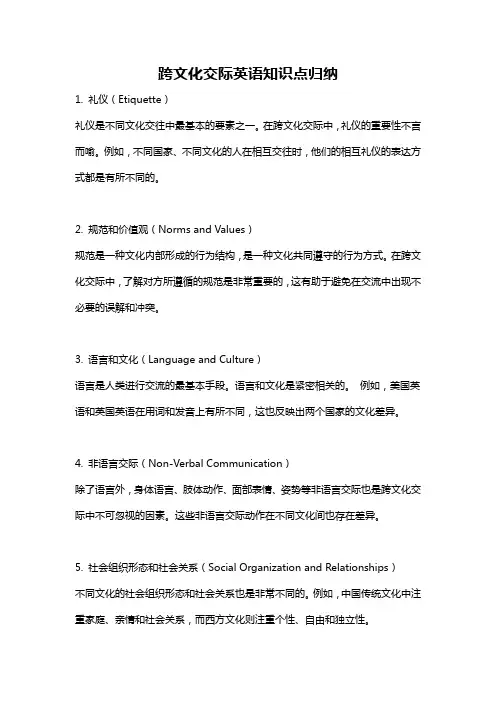
跨文化交际英语知识点归纳1. 礼仪(Etiquette)礼仪是不同文化交往中最基本的要素之一。
在跨文化交际中,礼仪的重要性不言而喻。
例如,不同国家、不同文化的人在相互交往时,他们的相互礼仪的表达方式都是有所不同的。
2. 规范和价值观(Norms and Values)规范是一种文化内部形成的行为结构,是一种文化共同遵守的行为方式。
在跨文化交际中,了解对方所遵循的规范是非常重要的,这有助于避免在交流中出现不必要的误解和冲突。
3. 语言和文化(Language and Culture)语言是人类进行交流的最基本手段。
语言和文化是紧密相关的。
例如,美国英语和英国英语在用词和发音上有所不同,这也反映出两个国家的文化差异。
4. 非语言交际(Non-Verbal Communication)除了语言外,身体语言、肢体动作、面部表情、姿势等非语言交际也是跨文化交际中不可忽视的因素。
这些非语言交际动作在不同文化间也存在差异。
5. 社会组织形态和社会关系(Social Organization and Relationships)不同文化的社会组织形态和社会关系也是非常不同的。
例如,中国传统文化中注重家庭、亲情和社会关系,而西方文化则注重个性、自由和独立性。
6. 时间观念(Time)不同国家和文化对时间观念的重视程度也存在差异。
例如,在日本文化中,迟到被看作是不尊重别人的行为,而在西方文化中,稍微迟到几分钟不会被认为是什么大问题。
7. 社会礼仪和礼节(Social Etiquette and Formalities)在跨文化交际中,了解对方的社会礼仪和礼节也是非常重要的。
例如,上司和下属之间的交往在不同文化中有着不同的礼节和规范。
8. 语言表达方式和文化复杂性(Language Expression and Cultural Complexity)语言表达方式和文化的复杂性也是跨文化交际中重要的要素之一。
不同文化的语言表达方式有着不同的复杂度和难度,了解这些差异有助于更好地理解对方文化的复杂度。
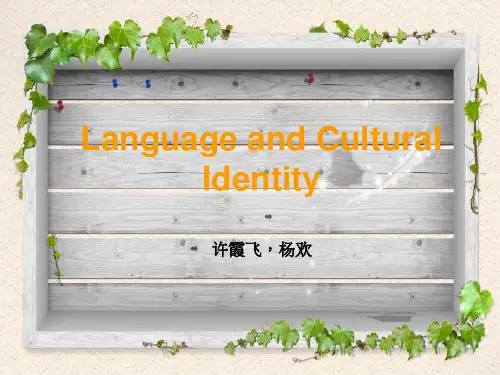
Language and Culture语言和文化Languages are marvelously complex语言是极其复杂and wonderfully complicated organs of culture:难解的文化工具:they embody the quickest and the most efficientmeans of communicating 它们是最快捷最有效的交流思想的方法within their respective culture.在各文化中。
To learn a foreign language is to learn another culture.学习外语就等于学习另一种文化。
In a words of a poet and philosopher,一位诗人兼哲学家曾经这样说过:"As many languages as one speaks, so many lives one lives.""你懂几种外语,你就过着几种不同的生活。
"A culture and its language are as inseparable as brain and body;文化及其语言正像人脑与人体一样不可分割。
while one is a part of the other,neither can function without the other. 虽然其中一个是另一个的部分,但是失去一部分,另一部分就不能运作。
In learning a foreign language, the best beginning学习外语最好的开始是is with the non- verbal linguistic elements of the language,从这种语言的非语言的语言成分开始,its gestures,its body language.即从手势,体语开始。
语言与文化的关系800字英语作文Language and Culture: A Symbiotic Interdependence.Language, the intricate tapestry of words and grammar, serves as the bedrock of human communication. It is through language that we express our thoughts, emotions, and experiences, shaping our perceptions of the world around us. However, language is not merely a tool for conveying information; it is inextricably intertwined with culture, the complex web of traditions, beliefs, and practices that define a society.The symbiotic relationship between language and culture is undeniable. Language is a product of culture, reflecting the values, norms, and worldview of a particular group. The words we use, the phrases we construct, and the stories we tell all carry the imprint of our cultural heritage.For instance, in the Navajo language, there are nowords for "left" or "right." Instead, speakers use termssuch as "east" and "west," reflecting the tribe'straditional orientation to the cardinal directions. Similarly, the Inuit language has a vast vocabulary describing different types of ice and snow, a testament to their profound understanding of their Arctic environment.Conversely, language also shapes culture. By providing the means to articulate beliefs, values, and norms, language influences the way individuals think, feel, and behave. The vocabulary we possess, the stories we share, and the conversations we engage in all contribute to our understanding of ourselves and the world.Take, for example, the concept of "ubuntu" in the Zulu language. Ubuntu refers to a profound sense of interconnectedness and humanity, encapsulating values of empathy, compassion, and social responsibility. Through the use of this term, the Zulu culture promotes a harmonious and supportive community.The interdependence between language and culture is further evident in the phenomenon of linguistic relativity.The Sapir-Whorf hypothesis suggests that the structure of a language influences the way its speakers perceive reality. Languages that lack certain grammatical features, such as the past tense in Hopi, may lead to different cognitive processes in time perception.Moreover, language serves as a repository of cultural knowledge and traditions. Oral histories, legends, proverbs, and folktales are passed down through generations, preserving the collective memory and wisdom of a people.The transmission of this cultural heritage through language ensures its continuity and vitality.In conclusion, language and culture are two sides ofthe same coin. They are inextricably intertwined, mutually reinforcing and shaping one another. Language is areflection of culture, providing a window into the beliefs, values, and practices of a particular group. Conversely, language also plays a pivotal role in shaping culture, influencing the way individuals think, feel, and behave. By recognizing and appreciating this symbiotic relationship,we can gain a deeper understanding of ourselves, ourcultures, and the diverse ways in which we communicate and connect with the world.。
Language and CultureI firmly believe that language and culture are familiar with everyone on earth. Nevertheless, I don’t think everyone is clear about the real meaning of language and culture. On this basis, this essay will explain some basic information about language and culture, including what is language, what is culture and the relationship between language and culture. What’s more, quite a number of examples will be cited to help you have a better understanding of language and culture.Let’s begin with the concept of language. When we put a key word “language”into the online Wikipedia(维基百科),which is a free encyclopedia to people all over the world, we find that language is defined as the human capacity for acquiring and using complex system of communications , and a language is any specific example of such a system. From this definition, we have a clear consciousness towards language. When we look into the Oxford English-Chinese Dictionary, Language is divided into several meanings as follow:1. use of words in an agreed way as a method of human communications 2. system of words of a particular community or country etc. 3. faculty of speech 4. system of symbols and rules for writing computer programs 5. any method of communication.6. professional or specialized vocabulary. Besides, I have also learned the definition of language from my linguistics class. In the book A New Concise Course in Linguistics for Students of English(新编简明英语语言学教程). Langue is thought to be a system of arbitrary vocal symbol used for human communication. Short as it is, this definition has captured the main features of language. First of all, language is a system, that is, elements of language are combined according to rules. Second, language is arbitrary in the sense that theme is no intrinsic connection between a linguistic symbol and what the symbol stands for. This conventional nature of language is well illustrated by a famous quotation: A rose by any other name would smell as sweet. This quotation means rose is still rose even it is called by another name.For my part, the definition of language is varied. Generally speaking, it is a series code that facilitates human communication. And beyond a specific context, language has no intrinsic meaning.After finishing talking about what is language, let’s know more about culture. Similarly, in the Wikipedia, culture is defined as fallowing meanings, Firstly, culture is deemed as a modern concept based on a term first used in classical antiquity by the roman orator Cicero: Cultura animi ( cultiration of the soul). Secondly, the term “culture”in American anthropology had two meanings: the evolved human capacity to classify and represent experiences with symbol, and to act imaginatively and creatively. Thirdly, Hoebel describes culture as an integrated system of learned behavior patterns and which are not a result of biological inheritance. Besides, we learn the meaning of culture from theIntercultural Communication course. Culture is defined as the group of people who share the same ancestry. There are also many renowned socialists give culture several definitions. For example, E.sapir once said that culture may be defined as what a societu does and thinks.Shortly, culture is involved in so many aspects that it is hard to give it an accurate definition. Put in another way, for different people, culture has very different meaning, according to their own value, education background, social status and so forth. So there is nothing to criticize when other’s understanding of culture is different from yours.Having known so much basic information about language and culture, we will have look at the relationship between language and culture. In the book Intercultural communication in English(新编跨文化交际英语),there is a description of the relationship between language and culture. It goes like this: culture and language are intertwined and shape each other. Language is not a matter of neutral codes and grammatical rules. Each time we select words form sentences, and send a message, either oral or written. We also make cultural choices. We all agree that language helps in communication with people from different backgrounds. However, we may be less aware that cultural literary is necessary to understand the language being used. Personally speaking, language and culture is not two totally different subjects with no relevance. On the contrary, they are tightly related. That is to say, onlywhen language is put into a specific environment of cultural context does it have some real meaning.To have a better understanding of language and culture, several typical examples of the language and cultural difference between China and the western countries will be cited. We all know that the Chinese culture is both profound and extensive which leads to numerous idioms, allusions, proverbs and sayings, which is hard for foreigners to understand. Take some of them for instances. Firstly, take “过着牛郎织女的生活” for example, it can be literally translated as the Herd-boy and the spinning maid(mythical lovers separated by the Milky Way). But a foreigner may feel puzzled when look at this allusion, for they do not have the cultural background of the allusion. Actually, it is a folk tale of ancient China which means husband and wife living apart. If you want a foreigner fully understand this allusion, you’d better to tell him the whole tale, which also help him to know more about Chinese culture.There are also other four-character allusions in Chinese. Such as 三顾茅庐—make three calls at the thatched cottage(as Liu Bei did when he sought the aid of Zhuge Liang, a master straight then living in seclusion)—repeatedly request someone to take up a responsible post.完璧归赵——return the jade intact to the state of Zhao—return something to its owner in perfect condition.拔苗助长—stand by a stump waiting for hares to come and dash themselves against it—trust to chance and waiting forgains without pains.对牛弹琴—play music to an ox—cast pearls before swine.Most of the allusions come into being according to china’s long history. That’s why many foreigners find it hard to know comprehensively about Chinese language and culture. Nevertheless, there are some equivalents between these two different cultures. For example, in Chinese , there is an allusion called “画蛇添足” , in English, there is a similar proverb called gilding the lily. What’s more, it takes two to make a quarrel can be found in Chinese 一个巴掌拍不响. Hopefully, these make it easier to understand each other’s culture.In short, language in different cultures is hard to understand to most foreigners. The only thing to do is try one’s best to know more about each other’s culture, including all walks of life.。